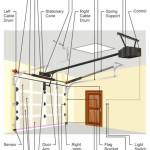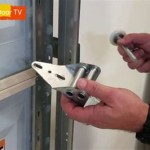How To Fill Cracks In Garage Floor
Garage floors, subjected to vehicular traffic, dropped tools, and environmental fluctuations, are prone to developing cracks over time. These cracks, if left unattended, can widen and deepen, compromising the structural integrity of the floor and potentially leading to more significant and costly repairs. Filling cracks promptly not only enhances the appearance of the garage floor but also prevents moisture intrusion, which can cause further damage, including rebar corrosion and concrete deterioration.
This article provides a comprehensive guide on how to effectively fill cracks in a garage floor, covering the necessary materials, tools, preparation steps, and application techniques. It aims to equip homeowners and DIY enthusiasts with the knowledge to undertake this repair with confidence and achieve a durable and aesthetically pleasing result.
Understanding the Types of Cracks
Before initiating any repair work, it is crucial to understand the different types of cracks that can appear in a garage floor. Distinguishing between them is essential for selecting the appropriate repair method and materials. Cracks are generally categorized as either structural or non-structural.
Structural cracks: These cracks are typically wider than 1/8 inch and indicate a problem with the foundation or underlying support. They may be caused by soil settlement, expansive soils, or insufficient concrete thickness. Structural cracks often run diagonally or horizontally across the floor and may be accompanied by vertical displacement (one side of the crack is higher than the other). Repairing structural cracks usually requires professional assessment and may involve addressing the underlying structural issues before filling the crack itself.
Non-structural cracks: These cracks are generally narrower than 1/8 inch and are often caused by shrinkage during the concrete curing process, temperature fluctuations, or surface wear and tear. These cracks don't typically signify a major structural issue and can be readily addressed with DIY methods. Hairline cracks, which are very fine surface cracks, are a common type of non-structural crack. While largely aesthetic, even hairline cracks can allow moisture penetration and should ideally be sealed.
Identifying the type of crack is paramount. If there is any doubt about the nature of the crack, consulting with a structural engineer or concrete specialist is highly recommended.
Materials and Tools Required
The success of any crack-filling project hinges on using the right materials and tools. The specific materials will depend on the width and depth of the cracks, as well as the desired aesthetic outcome. Below is a list of commonly used materials and tools:
Materials:
- Concrete Crack Filler: This is the primary material used to fill the cracks. Several types of crack fillers are available, including:
- Epoxy Crack Filler: Epoxy is a two-part system (resin and hardener) that, when mixed, creates a very strong and durable bond. It is suitable for filling wider cracks and structural cracks (after the underlying issue is addressed). Epoxy fillers are resistant to chemicals and abrasion.
- Polyurethane Crack Filler: Polyurethane is a flexible material that is well-suited for filling cracks that are subject to expansion and contraction due to temperature changes. It adheres well to concrete and is water-resistant.
- Concrete Patching Compound: A premixed or dry-mix mortar-like compound used for filling wider cracks and spalled areas. It is typically less expensive than epoxy or polyurethane but may not be as durable.
- Self-Leveling Sealant: Ideal for filling hairline cracks and providing a smooth, even surface. Self-leveling sealants are typically made of silicone or polyurethane and are easy to apply.
- Backer Rod (for wider cracks): A flexible foam rod inserted into wider cracks before applying the crack filler. It provides a backing for the filler, prevents it from sinking too deeply into the crack, and helps to conserve material.
- Concrete Cleaner/Degreaser: Essential for thoroughly cleaning the cracks and surrounding area before applying the filler.
- Water: For mixing dry-mix patching compounds and cleaning.
Tools:
- Wire Brush: Used to remove loose debris, dirt, and old sealant from the cracks.
- Chisel and Hammer: For widening narrow cracks to create a V-shaped groove, which provides a better bonding surface for the filler.
- Shop Vacuum: To remove dust and debris from the cracks after cleaning.
- Mixing Bucket and Stir Stick: For mixing two-part epoxy or patching compounds.
- Trowel or Putty Knife: For applying and smoothing the crack filler.
- Caulk Gun (for cartridge-based fillers): For dispensing crack filler from cartridges.
- Safety Glasses: To protect eyes from dust and debris.
- Gloves: To protect hands from chemicals and abrasion.
- Dust Mask: To prevent inhalation of dust and fumes.
Step-by-Step Crack Filling Process
The following steps outline the process for effectively filling cracks in a garage floor. Adhering to these steps will ensure a strong, durable, and aesthetically pleasing repair.
1. Preparation:
This is arguably the most crucial step in the crack-filling process. Thorough preparation ensures proper adhesion of the filler and a long-lasting repair. The preparation process involves the following:
- Cleaning the Area: Begin by sweeping the entire garage floor to remove any loose debris. Then, scrub the cracks and the surrounding area with a concrete cleaner or degreaser to remove dirt, oil, grease, and other contaminants. Rinse thoroughly with water and allow the area to dry completely.
- Removing Loose Debris: Use a wire brush to thoroughly clean the inside of the cracks, removing any loose concrete, dust, or old sealant. Pay particular attention to edges of the crack.
- Widening the Crack (If Necessary): For narrow hairline cracks or cracks with uneven edges, it may be necessary to widen them slightly using a chisel and hammer. Create a V-shaped groove along the length of the crack. This provides a larger surface area for the filler to bond to.
- Vacuuming the Cracks: After cleaning and widening, thoroughly vacuum the cracks to remove any remaining dust and debris. This ensures a clean surface for the filler to adhere to.
2. Applying Backer Rod (for Wider Cracks):
For cracks wider than 1/4 inch, inserting a backer rod before applying the crack filler is recommended. The backer rod serves several purposes:
- It provides a backing for the filler, preventing it from sinking too deeply into the crack.
- It helps to conserve filler material.
- It creates the proper depth-to-width ratio for the filler, which is essential for optimal performance.
Select a backer rod that is slightly wider than the crack. Compress the rod and insert it into the crack, using a screwdriver or putty knife to push it down to the desired depth. The backer rod should be recessed slightly below the surface of the concrete.
3. Mixing and Applying Crack Filler:
The mixing and application process will vary depending on the type of crack filler being used. Follow the manufacturer's instructions carefully.
- Epoxy Crack Filler: Mix the resin and hardener according to the manufacturer's instructions. Use a mixing bucket and stir stick to ensure thorough mixing. Apply the epoxy filler to the cracks using a trowel or putty knife, pressing it firmly into the crack to ensure good adhesion. Overfill the crack slightly, as the epoxy may shrink slightly as it cures.
- Polyurethane Crack Filler: Many polyurethane crack fillers are available in cartridges that can be dispensed using a caulk gun. Cut the tip of the cartridge at a 45-degree angle and insert it into the caulk gun. Apply the filler to the cracks, ensuring that it fills the entire void. Smooth the surface of the filler with a trowel or putty knife.
- Concrete Patching Compound: Mix the dry-mix patching compound with water according to the manufacturer's instructions. Apply the patching compound to the cracks using a trowel, pressing it firmly into the crack to ensure good adhesion. Overfill the crack slightly and smooth the surface with a trowel.
- Self-Leveling Sealant: Apply the self-leveling sealant directly to the cracks, allowing it to flow into the voids. The sealant will automatically level itself, creating a smooth, even surface.
4. Finishing and Curing:
After applying the crack filler, allow it to cure according to the manufacturer's instructions. Curing times can vary depending on the type of filler and the ambient temperature and humidity. Keep the repaired area clean and dry during the curing process.
- Smoothing the Surface: Once the filler has partially cured, use a trowel or putty knife to smooth the surface and blend it seamlessly with the surrounding concrete. This will create a more aesthetically pleasing and durable repair.
- Protecting the Repaired Area: During the curing process, protect the repaired area from traffic and moisture. This will help to ensure that the filler cures properly and forms a strong bond.
By following these steps carefully, one can successfully fill cracks in a garage floor and restore its structural integrity and appearance.

How To Fix Cracks Crumbles And Breaks In Concrete Dap Global

Garage Floor Repair Kit How To Concrete Cracks

How To Permanently Repair A Garage Floor Crack

How To Fix Cracked Concrete Floor In Your Garage Danley S Garages

Cracks In Your Garage Floor Here S What To Do

Concrete Garage Floor Repair

How To Fix Cracks Crumbles And Breaks In Concrete Dap Global

How To Repair Garage Floor Cracks All Floors

How To Fix Cracked Concrete Putting Two Methods The Test Renee Renovates

Repairing Common Concrete Slab Problems Network








